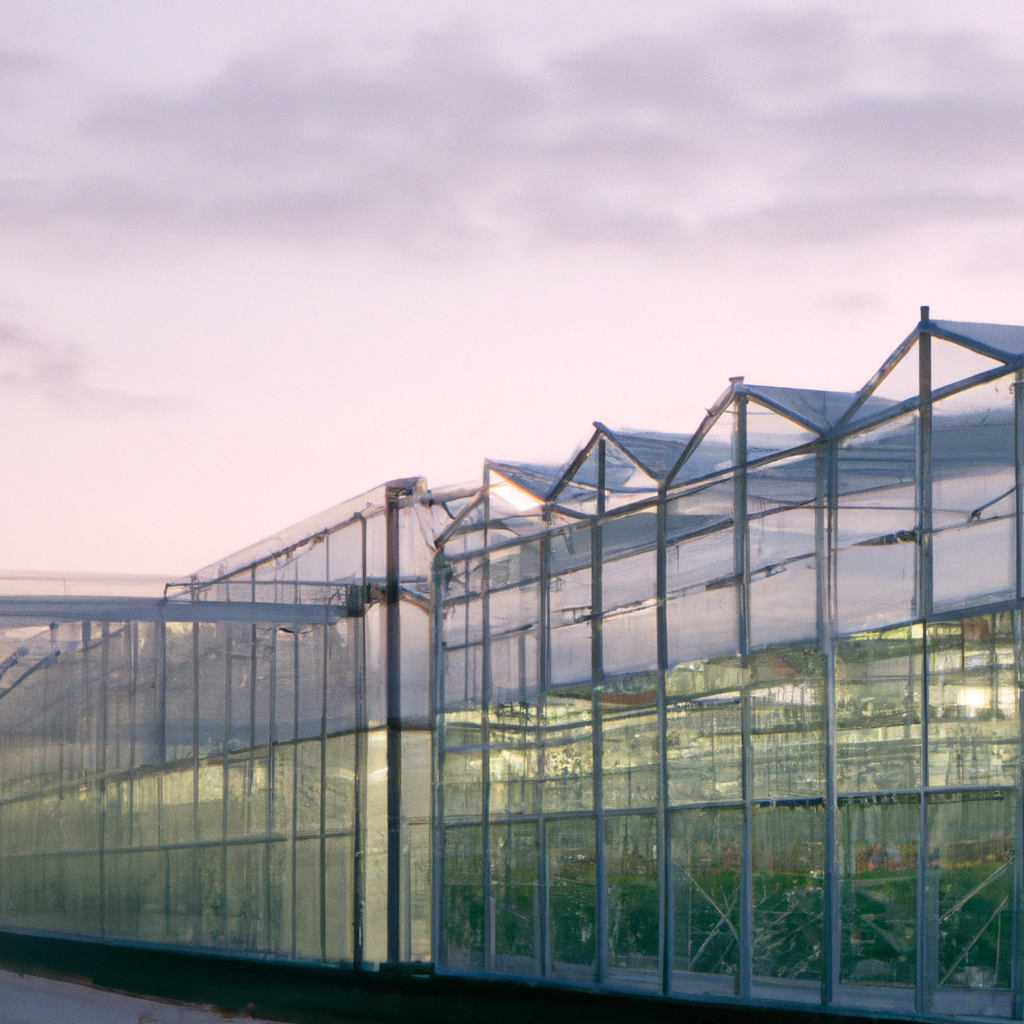
Imagine having the ability to grow your own flowers, vegetables, and fruits year-round, regardless of the unpredictable weather outside. Greenhouses, those remarkable structures made of glass or plastic, provide the perfect solution for avid gardeners and commercial farmers alike. These enclosed spaces create a controlled environment that allows plants to thrive, shielding them from harsh conditions while providing an optimum balance of sunlight, temperature, and humidity. Not limited to a specific purpose, greenhouses are used for everything from extending the growing season to cultivating delicate plants, experimenting with different growing techniques, and even preserving endangered species. Step inside these marvels of horticulture, and unlock the endless possibilities awaiting you.

Plant cultivation
Plants require certain conditions to grow and thrive, and greenhouses provide the perfect environment for optimal plant cultivation. One of the key factors in successful plant growth is temperature control. Greenhouses allow you to regulate the temperature, creating the ideal climate for your plants. By adjusting the heating and cooling systems, you can ensure that your plants are always in a comfortable temperature range, regardless of the outside weather conditions. This is particularly important for fragile or sensitive plants that may not survive in harsh or fluctuating climates.
In addition to temperature control, greenhouses also offer protection from unpredictable weather conditions. Harsh winds, heavy rains, and hailstorms can damage or even destroy crops. With a greenhouse, you can shield your plants from these elements, ensuring their safety and reducing the risk of crop loss. The transparent structure of the greenhouse allows sunlight to penetrate while acting as a barrier against the wind, rain, and other weather hazards.
Another advantage of using greenhouses for plant cultivation is the ability to extend the growing season. In areas with short or unpredictable growing seasons, greenhouses provide a controlled environment that enables plants to thrive for longer periods. By starting seeds indoors and then transplanting them into the greenhouse, you can kickstart the growing process earlier and enjoy the harvest for an extended period. This can be particularly beneficial for growing crops that require warmer temperatures or have a longer maturation period.
Furthermore, greenhouses provide optimal growing conditions that are not easily achievable outdoors. The controlled environment creates a stable and consistent atmosphere for plants, allowing them to grow faster and healthier. The greenhouse atmosphere also helps to optimize factors such as humidity, light intensity, and carbon dioxide levels. With the ability to fine-tune these parameters, you can create the perfect conditions to maximize plant growth and yield.
Propagation of Plants
The propagation of plants is a crucial aspect of horticulture, and greenhouses offer an ideal setting for various propagation methods. Seed germination is one common technique used to start plants from seeds. By providing the right temperature, moisture, and light conditions in a greenhouse, you can significantly increase the success rate of seed germination. The controlled and protected environment of the greenhouse ensures a higher survival rate for delicate seedlings.
Grafting and cloning are additional propagation techniques commonly employed in greenhouse settings. Grafting involves merging the tissues of two different plants to create a new plant with desired characteristics. Cloning, on the other hand, involves taking cuttings from a parent plant and rooting them to produce genetically identical offspring. Greenhouses provide a stable environment necessary for the success of these techniques, ensuring the survival and growth of grafted or cloned plants.
Moreover, greenhouses play a vital role in nursery production. This process involves growing young plants, also known as “starts,” that are then transplanted for further growth. Greenhouses provide the controlled conditions needed for healthy and vigorous nursery production. By carefully monitoring factors such as temperature, light, and humidity, you can ensure the production of robust and high-quality nursery plants.
Research and Experiments
Greenhouses are invaluable for horticultural research and experimentation purposes. One area of focus is plant breeding, where scientists work to develop new plant varieties with improved traits, such as disease resistance or higher yield. Greenhouses provide a controlled environment for cross-pollination and seed development, allowing researchers to carefully manipulate and select for desired traits. This enables the development of new and improved plant varieties that meet specific market demands.
In addition to plant breeding, greenhouses are used for studying plant physiology. Researchers can closely observe and analyze plant growth and development in a controlled environment, free from external influences that could affect the results. By studying factors such as photosynthesis, respiration, and nutrient uptake, researchers gain a deeper understanding of plant physiology and contribute to advancements in agricultural practices.
Furthermore, greenhouses serve as testing grounds for new growing techniques. From hydroponics to vertical farming, innovative methods are continually being explored to maximize yield and minimize resource usage. Greenhouses provide researchers with a controlled environment to test and tweak these techniques, ensuring their feasibility and effectiveness before implementation on a larger scale. This allows for the refinement of sustainable and efficient growing methods that benefit both commercial growers and the environment.
Protection from Pests and Diseases
One of the significant advantages of using greenhouses is the ability to protect plants from pests and diseases. The controlled environment within a greenhouse acts as a physical barrier against insects such as aphids, mites, and whiteflies. Since greenhouses are enclosed structures, it is easier to monitor and control the pest populations, reducing the need for chemical pesticides. This helps prevent the damage caused by pests and ensures the overall health and productivity of the plants.
Greenhouses also provide protection against fungal and bacterial infections, which can spread rapidly in outdoor environments. The controlled humidity and ventilation in a greenhouse can be adjusted to minimize the conditions favorable for the growth of these pathogens. By maintaining optimal moisture levels and airflow, you can greatly reduce the risk of diseases that can devastate crops.
Additionally, greenhouses allow for the isolation of plants, which is crucial in preventing the spread of diseases. By separating infected plants from healthy ones, you can contain the problem and prevent it from affecting other crops. This not only protects the plants themselves but also helps maintain the overall health and productivity of the greenhouse, creating a more sustainable and efficient growing environment.

Production of Specialty Plants
Greenhouses are ideal for the production of specialty plants, including rare and exotic species. These plants often have specific environmental requirements that may not be met in an outdoor garden. Greenhouses offer a controlled environment where temperature, humidity, and other factors can be easily adjusted to create the perfect conditions for these unique plants to thrive. This enables the cultivation of rare and exotic species that are not commonly found in the local climate.
Orchid and flower production is another area where greenhouses excel. These delicate and often temperature-sensitive plants require a stable and controlled environment to bloom and flourish. Greenhouses provide the necessary conditions for the successful cultivation of these beautiful blooms, ensuring a continuous supply of fresh flowers for various purposes, including floristry, event decorations, and personal enjoyment.
Moreover, greenhouses play a vital role in the cultivation of herb and vegetable crops. With the growing demand for fresh, organic produce, greenhouse cultivation allows for year-round production, regardless of the external climate. By carefully managing temperature, light, and nutrient levels, you can consistently harvest a wide range of herbs and vegetables. This provides consumers with access to high-quality, locally grown produce, even during off-seasons or in regions with challenging growing conditions.
Additionally, greenhouses are capable of housing aquatic plants, such as water lilies and lotuses. These plants require specific water depths and temperatures to thrive. Greenhouses with built-in water features, such as ponds or containers, provide the controlled aquatic environment needed for the successful growth of these beautiful plants. This allows for the creation of stunning aquatic displays and the cultivation of water-loving plants in areas where they may not naturally thrive.
Year-round Flower and Vegetable Production
One of the significant advantages of using greenhouses is the ability to achieve year-round flower and vegetable production. By controlling the climate within the greenhouse, you can create a stable and consistent environment for plant growth. This controlled environment ensures a continuous supply of fresh produce, regardless of the season or location.
Stable climate control is a key factor in year-round greenhouse production. Greenhouses are equipped with heating and cooling systems that maintain the optimal temperature range for plants. This allows you to grow flowers and vegetables throughout the year, regardless of the fluctuations and extremes of the outside climate. Whether it’s a cold winter or scorching summer, the greenhouse serves as a haven where plants can thrive and provide a bountiful harvest.
The continuous supply of fresh produce offered by greenhouses also meets the demand for off-season flowers. Flowers are a popular gift for various occasions, such as Valentine’s Day, weddings, and anniversaries. With greenhouses, florists and growers can ensure a steady supply of fresh flowers, even during traditionally slower growing periods. This not only benefits businesses, but it also brings joy and beauty to individuals by allowing them to enjoy seasonal flowers year-round.
From a commercial standpoint, year-round greenhouse production is highly profitable for growers. Investing in greenhouse infrastructure and technology allows growers to produce high-value crops, such as specialty flowers and vegetables, throughout the year. The ability to supply the market with off-season produce often commands higher prices, resulting in increased profitability for the growers. This economic advantage makes greenhouse production an attractive option for commercial growers looking to maximize their yields and profits.

Protection of Delicate Plants
Greenhouses provide an ideal environment for the protection of delicate plants that are sensitive to extreme temperatures. Tropical and subtropical plants, for example, require warm and humid conditions to thrive. Greenhouses allow for the creation of the perfect microclimate, replicating the native habitat of these plants. By maintaining a stable temperature and humidity level, greenhouse cultivation ensures the survival and healthy growth of these delicate species.
Furthermore, greenhouses offer protection against frost and cold temperatures. In regions where freezing temperatures occur, delicate plants are at risk of damage or death. The insulated structure of the greenhouse provides a barrier against frost, keeping the interior temperature higher than the outside environment. This protection prevents frost damage and allows for the successful cultivation of temperature-sensitive plants in colder climates.
Cultivating delicate herbs is another aspect where greenhouses excel. Herbs such as basil, cilantro, and mint are highly sensitive to temperature fluctuations. Greenhouses provide the necessary protection and stability to grow these herbs successfully, ensuring a fresh and abundant supply year-round. Whether it’s a warm summer or a chilly winter, the greenhouse environment allows for the cultivation of delicate herbs, providing a constant source of flavor and culinary delight.
Education and Training
Greenhouses serve as valuable educational tools for learning about horticulture. They offer a hands-on experience for students, allowing them to observe plant growth and interact with various cultivation techniques. Students can learn about the different aspects of greenhouse management, including temperature control, pest management, and propagation techniques.
Gardening workshops are often conducted within greenhouses, providing individuals with practical knowledge and skills in plant care and cultivation. These workshops offer a platform for both beginners and experienced gardeners to expand their understanding of horticulture. From seed starting to plant care, participants can gain insights into the best practices for successful greenhouse gardening.
Greenhouses also contribute to professional development opportunities for horticulturalists and agricultural professionals. Through seminars, conferences, and industry events held within greenhouses, professionals can stay up-to-date with the latest advancements in greenhouse technology and practices. This encourages the dissemination of knowledge and fosters a supportive and collaborative community in the horticulture industry.

Improvement of Energy Efficiency
Greenhouses are continuously evolving to improve energy efficiency and reduce environmental impact. The insulation of a greenhouse plays a crucial role in reducing heat loss during colder months. Materials like double-glazed glass or polycarbonate panels help retain heat within the structure, minimizing the need for excessive heating. By enhancing insulation, growers can reduce their energy consumption while still maintaining a suitable environment for plant growth.
Efficient use of natural resources is another aspect of greenhouse design aimed at reducing energy consumption. Utilizing natural sunlight as the primary source of light reduces the reliance on artificial lighting systems. This not only conserves energy but also provides plants with the full spectrum of light necessary for optimal growth. By harnessing the power of the sun, growers can minimize their carbon footprint and create a more sustainable growing environment.
Conservation of water and energy is a significant consideration in greenhouse operations. Water-saving techniques, such as drip irrigation systems and water recycling, help in minimizing water usage. By optimizing irrigation practices and reusing water, growers can reduce their water consumption while still providing the necessary hydration to their crops. Similarly, implementing energy-efficient technologies, such as LED lighting and energy-conscious HVAC systems, further reduces the greenhouse’s overall energy consumption.
The development of sustainable methods is an ongoing focus in the greenhouse industry. From renewable energy sources, such as solar power, to innovative cooling and heating techniques, growers are continually striving to create environmentally friendly greenhouse systems. These sustainable advancements contribute to reducing the industry’s environmental impact, making greenhouse production a more sustainable and responsible choice.
Recreation and Therapy
Greenhouses provide more than just a practical growing environment; they also offer spaces for recreation and therapy. Greenhouse gardens serve as tranquil oases where individuals can escape the stress of everyday life. The lush greenery, vibrant blooms, and soothing atmosphere provide a serene setting for relaxation and stress relief. Whether it’s enjoying a cup of tea surrounded by plants or practicing mindfulness among the greenery, greenhouses offer a therapeutic retreat for individuals seeking solace and rejuvenation.
Horticultural therapy programs utilize greenhouses as therapeutic spaces for various populations, including individuals with physical or mental disabilities, the elderly, and those recovering from trauma. Engaging in gardening activities, such as planting, nurturing, and harvesting plants, can have positive effects on mental and emotional well-being. The act of tending to plants and witnessing their growth can instill a sense of accomplishment, purpose, and connection with nature. Greenhouses provide these therapeutic benefits within a controlled and accessible environment, allowing individuals to participate in meaningful and fulfilling activities.
Furthermore, greenhouses serve as a platform for community engagement. They create opportunities for individuals of all ages and backgrounds to come together, learn, and share their love for plants. Community gardening projects and events held within greenhouses promote collaboration, environmental education, and social interaction. These initiatives strengthen community ties, foster a sense of belonging, and empower individuals to make a positive impact on their local environment.
In conclusion, greenhouses play a vital role in various aspects of plant cultivation, horticultural research, and human well-being. From offering optimal growing conditions to protection against pests and diseases, greenhouses provide a controlled environment that enhances plant growth and productivity. They enable the propagation of plants through various techniques, contributing to the development and diversification of plant species. Greenhouses also facilitate research and experimentation, leading to advancements in horticulture and the development of sustainable growing methods.
Moreover, greenhouses allow for the production of specialty plants, year-round flower and vegetable cultivation, and the protection of delicate species. They promote education and training in horticulture, offering hands-on experiences and learning opportunities. Greenhouses also focus on energy efficiency, utilizing sustainable practices to reduce environmental impact. Additionally, greenhouses serve as spaces for recreation and therapy, providing relaxation, stress relief, and horticultural therapy programs. Overall, greenhouses are versatile and essential structures that serve multiple purposes, benefiting individuals, communities, and the environment.


